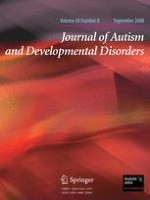01-09-2008 | Original Paper
Evidence for Impairments in Using Static Line Drawings of Eye Gaze Cues to Orient Visual-Spatial Attention in Children with High Functioning Autism
Gepubliceerd in: Journal of Autism and Developmental Disorders | Uitgave 8/2008
Log in om toegang te krijgenAbstract
We examined the ability to use static line drawings of eye gaze cues to orient visual-spatial attention in children with high functioning autism (HFA) compared to typically developing children (TD). The task was organized such that on valid trials, gaze cues were directed toward the same spatial location as the appearance of an upcoming target, while on invalid trials gaze cues were directed to an opposite location. Unlike TD children, children with HFA showed no advantage in reaction time (RT) on valid trials compared to invalid trials (i.e., no significant validity effect). The two stimulus onset asynchronies (200 ms, 700 ms) did not differentially affect these findings. The results suggest that children with HFA show impairments in utilizing static line drawings of gaze cues to orient visual-spatial attention.
